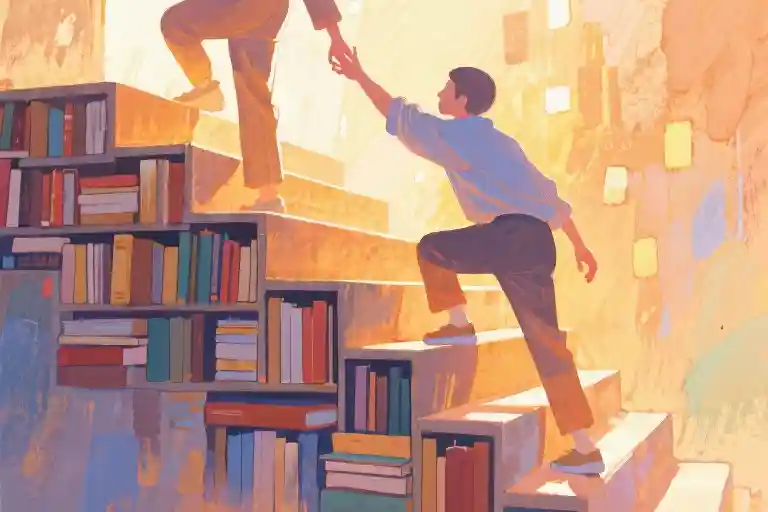“But I don’t have anything unique or amazing to share.” If I had a dollar for every time I’ve heard this from new writers, I could probably retire by now. It comes right after that other classic – “I don’t know where to start” – in the hierarchy of creative fears. And honestly? I get it. When you’re staring at blank pages and blinking cursors, comparing yourself to established writers who seem to have some magical well of wisdom, it’s easy to feel like an imposter.
Here’s what three years of coaching over 300 new writers has taught me: The material isn’t missing. You’re just wearing glasses that filter out your own knowledge as “not good enough.” That notebook where you scribbled lessons from your first failed startup? The spreadsheet where you tracked how you finally understood recursion in Python? The messy process of learning to negotiate your salary? All of that is gold waiting to be minted.
We’ve been conditioned to believe that only certified experts with decades of experience deserve to be heard. This creates what I call the Expertise Trap – the paralyzing belief that unless you’re the world’s foremost authority, your words don’t matter. It’s why brilliant people with valuable insights keep silencing themselves, waiting for some imaginary future when they’ll feel “qualified” enough to share.
The truth is much simpler: Your job isn’t to be the ultimate authority. It’s to be useful to someone specific. There will always be people who know more than you, just as there will always be people for whom your current understanding seems like wizardry. Writing isn’t about absolute expertise – it’s about relative usefulness.
Consider this: The things that feel obvious to you now were once confusing mysteries. That very gap between where you were and where you are contains all the raw material you need. You don’t need a PhD to help someone who’s two steps behind you on the path you’ve just walked. In fact, your fresh perspective makes you uniquely qualified to guide them – you remember exactly what those stumbling blocks feel like underfoot.
This realization changes everything. Suddenly, your perceived “lack” transforms into abundance. Those half-formed thoughts in your journal? They’re someone else’s lightbulb moments waiting to happen. The lessons you’re embarrassed took you so long to learn? They’re exactly what someone needs to hear today.
What makes writing terrifying is also what makes it powerful: You’re not delivering polished truth from some ivory tower. You’re reaching back to grab the hand of the person currently stuck where you once were. That messy, imperfect, deeply human connection is where the real magic happens.
The Expertise Trap: Why You Feel Unqualified
“I’m not expert enough to write about this.” If you’ve ever had this thought while staring at a blank page, you’re experiencing what I call the Expertise Trap. It’s that nagging voice insisting you need another certification, five more years of experience, or some undefined level of mastery before your words deserve an audience.
This trap manifests in three sneaky ways:
First, there’s the Perfection Delay – constantly postponing writing until some mythical future when you’ll ‘know enough.’ Second, the Comparison Spiral – measuring yourself against established authorities in your field and always coming up short. Finally, the Knowledge Discount – undervaluing what you’ve already learned because it feels obvious to you now.
Neuroscience explains this as our brain’s protective mechanism against potential embarrassment. That flutter of anxiety when considering sharing your knowledge? It’s the same neural pathways that once kept our ancestors from eating suspicious berries lighting up. The discomfort you feel isn’t proof of inadequacy – it’s proof you’re growing.
Here’s what most writing guides won’t tell you: Expertise isn’t a binary state you achieve, but a continuum where you’re always both teacher and student. The technical writer who just mastered pivot tables is infinitely more helpful to spreadsheet beginners than the programmer who forgot what confusion looks like.
You don’t need to be an expert to be useful. You just need to be one chapter ahead in someone else’s story.
The Two-Step Theory: Your Hidden Advantage
The moment you realize your greatest weakness as a writer might actually be your secret weapon—that’s when everything changes. Most beginners obsess over their lack of expertise, not seeing how their recent struggles contain precisely what someone else desperately needs to hear.
Here’s how it works: On any learning curve, the most valuable teacher isn’t the person at the peak. It’s the one who just climbed past the spot where others are currently stuck. When you documented your first successful sourdough loaf last month, your notes could help today’s frustrated bakers more than a Michelin chef’s advanced techniques. That Python script you finally debugged after three sleepless nights? For someone encountering the same error tomorrow, your raw troubleshooting notes are gold.
Take Jamie, who started a Substack sharing her clumsy attempts at watercolor painting. She nearly quit after comparing her work to professional artists—until realizing her target audience wasn’t gallery curators, but fellow beginners needing reassurance that imperfect first strokes are normal. Her post Why Your First 50 Paintings Should Look Bad went viral in art teacher forums.
Try This Now
- Grab a notebook and jot down three skills you’ve improved in the past six months (no matter how small)
- For each, recall one specific obstacle you overcame
- Ask: Who’s currently facing this exact frustration?
That gap between their struggle and your hard-won solution? That’s your content sweet spot. You’re not writing for people decades ahead (they’re not reading you anyway), nor for complete novices (they don’t know what questions to ask). Your perfect reader is the version of you from three months ago.
This changes how you view your so-called limitations. Those grammar hiccups you’re self-conscious about? They make your writing more approachable to non-native speakers. The niche hobby you think is too obscure? Its tiny passionate community is starving for content. Even your false starts and abandoned projects contain lessons—I’ve seen writers turn failed business attempts into their most shared posts (7 Early Mistakes That Cost Me $2,000).
The magic happens when you stop waiting to feel qualified and start noticing how many people are just behind you on the path. Their hands are reaching for exactly what you’ve already figured out.
From Theory to Action: Your First 100 Readers
The gap between knowing what to do and actually doing it is where most writers get stuck. You might nod along to the two-step theory, even feel that spark of recognition when we talk about the expertise trap. But then comes the quiet panic: Okay, but how do I start?
This is where the rubber meets the road. Let me walk you through the three pillars of building your initial readership, the same framework that’s helped my students go from blank pages to engaged audiences.
Positioning Before Creating
Most beginners rush to produce content without answering one critical question: Who exactly needs what you know? The free course dedicates an entire module to this because misalignment here wastes more effort than any other mistake.
We use a simple filtering exercise:
- List every skill or insight you’ve gained in the past year (yes, even that niche Excel trick)
- For each item, ask: Who frequently asks beginners questions about this?
- Note where you feel disproportionate excitement – that’s your content sweet spot
One student, a graphic designer named Marco, nearly skipped this step. He assumed he had to teach advanced Illustrator techniques to be valuable. Our exercise revealed his real superpower: helping small business owners create basic but professional-looking social media graphics. That became his focus, and within six weeks, he’d built a following of 87 genuinely engaged readers.
Content That Converts Lurkers to Readers
There’s a dangerous myth that you need viral-level brilliance to attract an audience. The truth is far simpler: consistency beats genius every time for new writers.
The course breaks down a no-fail content structure we call the ‘Breadcrumb Method’:
- Monday: Share a raw struggle you’re currently facing (e.g., ‘Why I can’t stick to a writing schedule’)
- Wednesday: Post the solution you discovered (e.g., ‘The 15-minute trick that changed everything’)
- Friday: Curate 3-5 resources that helped you (tools, books, podcasts)
This rhythm works because it mirrors how real expertise develops – messy, incremental, and deeply human. When another student, Priya, adopted this approach for her coding blog, something remarkable happened. Her comments shifted from ‘Thanks for the tutorial’ to ‘This is exactly where I’m stuck too.’ That’s the sound of connection.
The Gentle Art of Self-Promotion
Here’s the uncomfortable truth no one tells beginners: Good writing alone rarely finds its audience. You must become a gracious promoter of your own work.
The course teaches promotion as a service, not a nuisance. For example:
- Instead of blasting ‘Read my latest post!’ try ‘Know someone struggling with writer’s block? This might help them [link]’
- When sharing in communities, lead with vulnerability: ‘I used to _ until I learned _. Wrote about it here if useful’
Jessica, a nutritionist, resisted self-promotion until she reframed it this way. Her newsletter grew from 12 to 103 subscribers when she started adding: ‘If this resonated, would you forward it to one person who might need it today?’ The psychology is sound – people enjoy feeling helpful.
The Enrollment Window
We open course access briefly each month to maintain community quality. The next cohort starts in 30 days, but early registrants get immediate access to the ‘100 Readers Starter Kit’ – a collection of templates, swipe files, and my personal outreach scripts.
What surprises students most isn’t the tactics, but the mindset shift. As one recent participant put it: ‘I stopped waiting to feel qualified and started focusing on being useful. The readers followed.’
Your turn.
Your Unique Perspective is Someone Else’s Lifeline
That nagging voice whispering “you have nothing special to offer”? It lies. What feels ordinary to you could be revolutionary for someone just two steps behind. The spreadsheet trick you automated last week? That’s a lightbulb moment waiting to happen for dozens of beginners. The way you structured your first blog post? Exactly what an anxious new writer needs to see.
This isn’t about becoming the next Hemingway or Marie Kondo. It’s about being the guide you needed six months ago. Remember how lost you felt trying to format your first newsletter? Someone’s Googling that exact problem right now. Your solution—even if it’s messy and imperfect—could save them hours of frustration.
We’ve built the free course specifically to help you bridge that gap between “I’m no expert” and “I can actually help people.” Inside, you’ll find:
- The Reader Magnet Method: How to create one piece of content that naturally attracts your first 100 readers (works even with zero followers)
- The Confidence Hack: Transforming your “basic” knowledge into sought-after advice
- The Snowball System: Turning early readers into vocal advocates without paid ads
Enrollment closes in 48 hours—not as a cheap tactic, but because we give personalized feedback to every student. The writers who joined last round averaged 83 new subscribers within two weeks using just the Module 1 strategies.
Want to see what happens after those first 100 readers? Tomorrow we’re sharing how our students are turning their growing audiences into paying clients—from $29 ebooks to $3,000 coaching packages. But first things first: Let’s get your words in front of people who need them.





